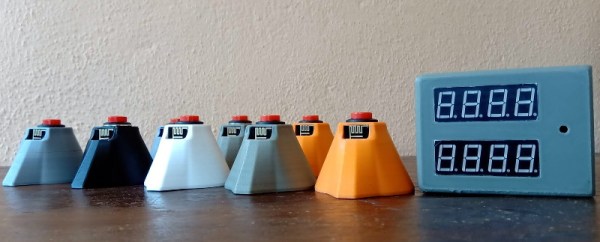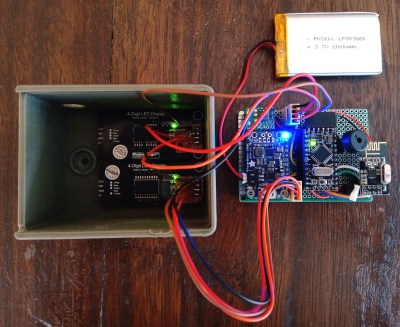Quiz Bowl Buzzer Systems Chea and Easy

Planning a game of Hacker Jeopardy at your next meetup? You're going to desire some proper buzzers to complete the feel, but why purchase when you can build? [Flute Systems] has released an open source DIY game buzzer system based on the Arduino that will assistance instantly elevate your game. Certainly beats just yelling across the room.
The blueprint has been fabricated to be every bit easily replicable as possible: as long every bit y'all've got admission to a 3D printer to run off the enclosures for the buzzers and base station, you'll exist able to follow along no problem. The balance of the project consists of modular components put together with jumper wires and scraps of perfboard. Granted it might not exist the virtuallyelegant solution, but in that location's something to be said for projects that beginners and sometime salts alike can complete.
 Each cablegram consists of an Arduino Pro Mini iii.iii V, a nRF24L01, and of course a big pushbutton on the tiptop. Each 1 is powered by a 110 mAh 3.7 Five LiPo bombardment, though [Flute Systems] notes that the electric current version of the buzzer tin't actually recharge it. You'll need to pull the pack out and charge it manually one time and awhile. Thankfully, the printed enclosure features a very clever twist-lock mechanism which makes it easy to open someday you lot need to poke at the internals.
Each cablegram consists of an Arduino Pro Mini iii.iii V, a nRF24L01, and of course a big pushbutton on the tiptop. Each 1 is powered by a 110 mAh 3.7 Five LiPo bombardment, though [Flute Systems] notes that the electric current version of the buzzer tin't actually recharge it. You'll need to pull the pack out and charge it manually one time and awhile. Thankfully, the printed enclosure features a very clever twist-lock mechanism which makes it easy to open someday you lot need to poke at the internals.
The base station uses the five V version of the Pro Mini, with a Adafruit PowerBoost 1000C to step upwards the voltage from its 2,000 mAh battery. Of course it also has a nRF24L01, and also adds a cablegram and twin iv digit seven-segment LED displays. [Flute Systems] says yous can expect about five hours of runtime for the base of operations station.
An specially nice feature of this setup is that the 8 digit display allows the base station to bear witness the number of each button in the order it was received. Then rather than just getting a display of who buzzed in kickoff, you can encounter the chronological order in which all 8 buttons were pressed. Coming up with clever applications for this adequacy is left equally an exercise for the reader.
Of form, there'south more one mode to build a buzzer. If yous don't like the fashion [Flute Systems] did information technology, and so check out this version that uses 900 MHz radios and an OLED to show the results.

TV game shows follow a formula that hasn't changed much in sixty years. The celebrity presenter, the glamorous assistant, the take hold of phrases, the gaudy plywood sets, the nervous contestants, and of course the buzzers.
If you desire to do a trivia quiz of your own it'southward easy enough to dispense with presenter, assistant, set, and grab phrase, but as well every bit the contestants you'll still need the buzzers. You can make a mess of wires that the TV technicians of old would have curtained within that gear up, but in your dwelling house or at the pub that could rapidly get inconvenient.
[Larry] solved his trivia game buzzer problems by building a wireless buzzer set. It features 3D printed enclosures containing Adafruit Feather microcontrollers, and instead of wires it uses RFM69 900MHz radio modules. The main unit displays the quickest contestant on an OLED screen, it features a low power standby way betwixt push button presses to save battery power, and care has been taken to add a random timing to button presses to try to avoid collisions.
The buttons themselves started with a 3D printed push working a unmarried tactile switch, but moved to a prepare of three switches in a triangle later on border presses failed to activate the unmarried switch.
Nosotros've featured a wired game bear witness buzzer before, simply for the complete game evidence experience how well-nigh this inaugural timer?

[Anthony] is experienced in the button arts, having made this political party push button for a hymeneals reception. His pattern for the quiz buttons is a picayune different. Each button has an Arduino Pro mini and an nRF24L01 wireless RF module. On the receiver side is an Arduino Pro micro and an another RF module. A connected PC captures the serial data and displays the pressed button'due south ID. It also shows the society in which subsequent buttons were pressed and the time elapsed between them.
The actually notable function of this build aside from the awesome laser-cut MDF Devo energy dome button housings is the extremely low ability consumption of the transmitting Arduinos. [Anthony] has designed them to go into slumber mode which disables all on-board circuitry and only wakes on interrupt. He removed the power LED and the voltage regulator since they run on two-AA batteries. The voltage regulator was drawing more 25mA in sleep mode. Because of these mods, each button consumes < 1μA, which is less power than the batteries tin can self discharge over their lifetime.
[Thanks Jef]

The iv colored buttons seen above are a production made by Learning Resource. They flash and make noise when pressed and are meant for quiz-prove style games in the classroom. The problem is that they don't utilise a fundamental controller, so information technology'southward up to the person running the game to judge who rang in start. [Kenny] fixed that event by building his own controller which is housed in that black project box.
He went with an Arduino Uno board. It fits in the project box and has no problem monitoring all of the buttons and triggering their sound and lights when necessary. There are two telephone jacks (RJ11 connectors) on either side of the controller. He too cracked open up each button, cutting some traces on the PCB in club to patch the signals into connectors he added to the housing.
The video after the break shows the system in action, In add-on to illuminating the starting time push button to ring in at that place are LEDs on the box that point who was 2nd, 3rd, and fourth in line.
If yous don't desire to purchase buttons try making your own with some inexpensive plastic bowls.
Continue reading "Hacking Quiz Game Buttons To Add A Fundamental Controller"

Theses are the squad buzzer boxes which [Philippe Chrétien] built for his mother. She's a big fan of quiz shows (we're thinking Jeopardy and the like) and he idea she'd enjoy a proper setup for home gaming.
Each unit consists of an arcade button and one LED, both housed in a projection box. He uses phone wire to connect each buzzer to the base of operations unit. We like that thought since we've got a lot of sometime telephone cable lying around and our RJ-45 crimp includes an RJ-xi slot. This is perfect for making our own cables.
The base unit houses an Arduino board which polls the buttons to see which is pressed first. The LED on the appropriate buzzer box is illuminated so the players know who got in first. One special feature of this setup is the ability to choose from thirty different cablegram sounds.
In that location are several other quiz buzzer projects kicking around Hackaday if you're interested. 1 of our favorites is this system which uses plastic bowls equally the buttons.
[via Adafruit]
Source: https://hackaday.com/tag/quiz-buzzer/
0 Response to "Quiz Bowl Buzzer Systems Chea and Easy"
Post a Comment